Ten Years' Digging 1848
Ten Years' Digging 1848 is in Ten Years' Digging.
The large barrow upon Middleton Moor, called Gib Hill [Map], situated about 350 yards west from the circular temple of Arborlow [Map], and connected with it by a serpentine ridge of earth, had been previously examined by the late Mr. William Bateman, in 1824, without much success. From the analogy borne by Arborlow and its satellite, Gib Hill, to the plan of Abury with its avenue of stones terminating in a lesser circle on the Hak Pen range of hills, no less than by the remarkable similarity of the names, I had ever reckoned this tumulus to be of more than common importance, under the supposition that a successful excavation of it might yield some approximate data respecting the obscure period of the foundation of the neighbouring circle.
Owing to the large size of the mound, our operations extended over several days, the result of each being noticed diary-wise as at once the most simple and intelligible arrangement.
January 10th was occupied in removing the upper part of the hill, the trench being commenced about half-way up its side, pretty much in the line of the former opening. A few splinters of animal bone and a flake of calcined flint, only, were the product of the day.
January 11th. - The cutting was carried forwards to the intended limit beyond the centre of the barrow, yielding in its progress more animal bones, a dog's tooth, numerous calcined flakes of flint, and a neatly formed arrow head of the same substance.
January 12th. - The trench being widened at each side, a space nearly, but not exactly, in the centre of the barrow, was found to consist of loose stones, whilst the outer part of the mound exposed to view by the section, was composed of tempered earth approaching the consistence of hard clay. In the course of this day a small piece of the border of an ornamented urn, a circular instrument| an arrow point, and many chippings of flint were found.
January 13th was passed in deepening the trench, principally through the before-named clay, varied by layers of decomposed wood and charcoal. From the appearance of the bark still remaining on some of these fragments, they were decided to be hazel. Amongst them were found animal bones and flints as before, one of the latter being a fine instrument of semicircular shape.
January 14th. - Our excavation was continued until the undisturbed surface of the earth was reached and laid bare for the space of 25 feet by 18, without disclosing any interment whatever; the appearance presented by the section of the barrow, here about 15 feet high, was as shewn in the diagram, thus making it evident that the tumulus had been originally raised over four smaller mounds, each consisting of indurated clay intermixed with wood and charcoal the superimposed materials being of a looser description. On the natural soil beneath the little mounds were flints as usual, one of them a round instrument, and large disconnected bones of oxen very much decayed.
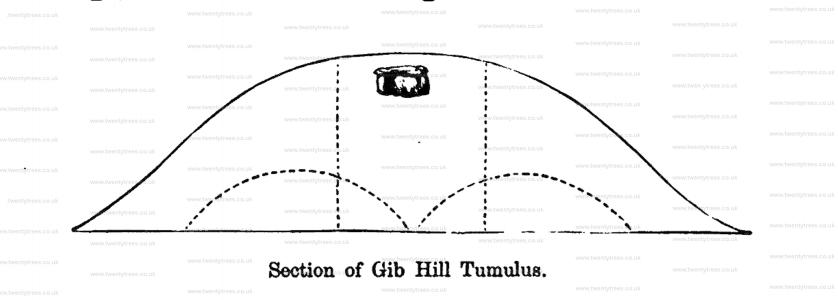
January 15th. - A tunnel was driven from the west side of the trench at right angles, in the hope of finding an interment, but after carrying it three or four yards it was deemed unsafe to continue it; and the supporting timbers being knocked away previous to abandoning the work, the whole superstructure fell in, and, much to our surprise, revealed the interment near the top of the mound, which we had been so laboriously seeking at its base. This consisted of a rectangular cist, measuring inside 2 feet 6 inches by 2 feet, composed of four massive blocks of limestone, covered in by a fifth of irregular form, averaging 4 feet square by 10 inches thick. The capstone was not more than eighteen inches beneath the turf clothing the summit of the barrow; in fact the men had been working directly under the cist for some time. By the sudden fall of two of the sides and the adjacent earth, a very pretty vase of small size was crushed to pieces the fragments mingling with the burnt human bones in company with which it had for ages occupied the sepulchral chamber. The urn measuring 4¼ inches in height, has since been restored almost to its original perfection; it is of that class of vessels indifferently deposited with human remains, burnt or unburnt, and which may probably have contained food or drink, but never the remains, as is the case with cinerary urns. A review of these facts leads to the conclusion that Gib Hill was not in the first instance a sepulchral mound, so large a portion of the interior having been removed down to the natural rock without any deposit of human remains being found, it appears impossible for any interment to have escaped observation at the base of the tumulus, where it would naturally have been placed at the time of its formation, had any such existed.
January 17th. - A molar tooth from the lower jaw of a horse, and a piece of white flint, were found in the rubbish that had fallen out of the cist the day before. The cist itself was removed and re-erected in conformity with its original plan, in the garden at Lomberdale House [Map], where it now remains.
The articles found in Gib Hill in 1824, comprise a battered celt of basaltic stone, a dart or javelin point of flint, and a small iron fibula which has been enriched with a setting of some precious stone now absent: the last was found in the upper part of the mound, and might have been deposited with a late interment which was destroyed about the year 1812, or earlier, in an abortive attempt to open the barrow. (See Vestiges of the Antiquities of Derbyshire, page 31.)
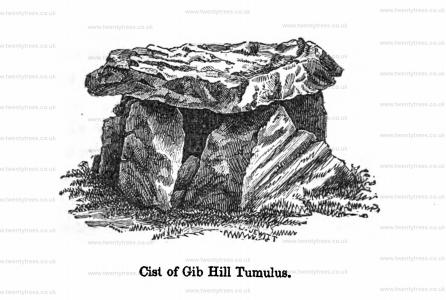
Books, Prehistory, Ten Years' Digging 1848, Kenslow Barrow
February 1st we commenced re-opening the barrow [Map] [Kenslow Knoll Barrow 1 [Map]] upon Kenslow Knoll, which was formerly investigated by Mr. William Bateman, in 1821, when it appears that the primary interment was discovered, and besides it, some other relics which indicated that there might still remain additional deposits in that part of the barrow that was not then disturbed. By taking a wide trench through the middle of the barrow from the outer edge, it became apparent that its convexity had chiefly been preserved by a border of large limestones placed with great regularity on the surface of the natural soil. On clearing the area within them, many pieces of calcined flint and animal bones were picked up; also a splinter from a stone celt, a round piece of slaty sandstone which had been burnt, and a crescent-shaped ornament of bone having two perforations: the latter is precisely like one found at the prior opening, and gives the idea of a large canine tooth of a wolf split down the middle, being convex on one surface and level on the other, although in reality it is cut out of solid bone, and has been carefully polished all over.
February 2nd. - The trenching of the barrow was continued, disclosing, near the centre, a depression below the natural level, which had contained the deposits formerly exhumed. In the course of the day pieces of three different urns were observed, one of coarse material and workmanship, another having been a neatly ornamented drinking cup, and lastly of a kiln-baked vessel of brick-red colour that had been made upon the wheel, and which must be therefore much more modem than the two former. There were also found three more of the bone crescents, part of a large ring of inferior jet or Kimmeridge coal, a small spatula of bone, probably used in the fabrication of pottery; a few instruments of flint, human and animal bones, both burnt and unbumt, and a tine from a stag's horn which has been roughly cut round, most probably with a flint saw.
February 3rd. - The excavation of the grave cut in the rock, which contained the previously discovered interments, was commenced: the rubbish being cleared out, we found some portions of the skeleton which had evidently lain undisturbed; with them was a small and neat bronze dagger, 3 inches long, with the three rivets by which the handle was attached, remaining. A little above these we found an iron knife of the shape and size usually deposited with Anglo-Saxon interments, which had most likely been thrown in unobserved when the grave was refilled in 1821. About the same place was a bone pin with a perforated head. By digging in the outer parts of the barrow, another bone crescent and several good instruments of flint were found.
February 4th. - The grave was very carefully cleared out, but yielded nothing further except a few burnt bones. In other parts of the mound we met with a seventh bone crescent, a bone javelin point, and some more flints. A comparison of the various relics found in this barrow in 1821 and 1848, with others brought to light in the course of these researches, demonstrates not only their varied antiquity, but also the order in which the successive interments had occupied the central grave. The first would be by cremation, the incinerated bones being placed in a coarse sepulchral urn, the fragments of which are before alluded to. The second would evidently consist of an unburnt skeleton, accompanied by a highly ornamented drinking cup, a decoration formed by a combination of the bone crescents, the bone lance heads, and the most carefully wrought instruments of flint; some of the latter would, however, be equally likely to pertain to the oldest interment.
The next occupants of the grave had not been disturbed until he former opening of the barrow in 1821, they were then described as being two in number, though sufficient care was not taken to discriminate the relics found with each: it is quite clear that the lowest (some of whose bones we found unremoved) had possessed the stone axe and the polished stone implement found in 1821, in addition to the bronze dagger found in 1848.
The other which lay higher up in the grave was of much later date, being the owner of the kiln-baked vessel, the iron knife, and the small copper fibula or ring-pin, found in 1821. The vessel appears, from the fragments remaining, to have had a narrow neck, and to have resembled that found at Brun-Cliff [Map] in 1847, (see Vestiges, page 101) in form, colour, and paste. It is the skull of this latest, and perhaps Romano-British skeleton, that is described in the former work.
Books, Prehistory, Ten Years' Digging 1848, Cross Flatts
February 10th. - A small barrow in the Cross Flatts' plantation was re-opened. Its sepulchral character was first ascertained in 1827, by a labourer engaged in making holes for planting, who found the skeleton of a young person, accompanied by an iron knife. On the present occasion no more interments were found, but in turning over the earth, the following articles were met with: - part of a large stag's horn, a celt of basaltic stone, some pieces of hand-mills, flints, and fragments of red pottery. On looking over the bones of the skeleton before disinterred, it was found that two of the lumbar vertebrae were attached together by an abnormal growth of osseous substance.
Books, Prehistory, Ten Years' Digging 1848, Parsley Hay
March 6th was passed in opening a cairn or tumulus [Map] [Parsley Hay Barrow [Map]] of stone in a plantation near the Parcelly Hay wharf of the Cromford and High Peak Railway. We found the primary interment beneath the middle of the barrow, in a small oval excavation in the rook below the natural surface of the land, about three feet in depth, and not exceeding the same in its greatest diameter, consequently the body had been placed upright in a sitting or crouching posture, as was abundantly evident from the order in which the bones were found. The grave was roughly covered in with large flat slabs of limestone, which had prevented the material of the tumulus from quite filling it up; a good deal of earth had, however, been washed in, which had the effect of preserving the bones in unusual perfection. The remains accompanying the body were of the poorest description, consisting merely of three pieces of chipped flint, some shreds from a drinking cup, and various animal bones and teeth, some of which were calcined. The fine skull from this interment has been engraved in the magnificent work by Messrs. Davis and Thumam, entitled "Crania Britannica," where its internal capacity is given at 72½ ounces; length of the femur, 18.3 inches. The high antiquity of this interment may be inferred when we take into consideration the fact, that upon the covering stones there lay another skeleton, quite unprotected from the loose stone of the barrow, and accompanied by weapons indicating that the owner lived at a very remote period. This body was badly preserved, owing to the percolation of water through the over lying stones, but it appeared to have been laid as usual upon the lefl side, with the knees slightly advanced; near the upper part of the person were placed a very elegantly formed axe head of granite, with a hole for the shaft, and a very fine bronze dagger of the earliest or archaic bronze period, with three studs for fastening the handle. The engraving gives an accurate section of this remarkable barrow,
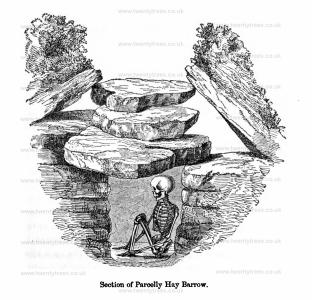
Books, Prehistory, Ten Years' Digging 1848, Barrows near Arbor Low
On the 15th of March, we re-opened a barrow near the boundary of Middleton Moor, in the direction of Parcelly Hay [Note. Possibly Parsley Hay Barrow [Map]], which was unsuccessfully opened by Mr.W. Bateman on the 28th of July, 1824; nor did our researches lead to a more satisfactory result, as the entire mound seemed to have been turned over by deep ploughing by which the interments, consisting of two skeletons and a deposit of burnt bones, had been so dragged about as to present no characteristic worthy of observation. A neat whetstone was picked up amongst these ruins, and a carefully chipped leaf-shaped arrow-point of flint has since been found by ploughing across the barrow. About fifty yards South-east of the last, is another barrow of very small size, both as to diameter and height; so inconsiderable indeed are its dimensions, that it was quite overlooked in 1824. Fortunately the contents, with the exception of one skeleton that lay near the surface, had been enclosed in a cist, sunk a few inches beneath the level of the soil. As in the companion barrow, the skeleton near the top was dismembered by the plough, so that it afforded nothing worthy of notice - the original interment, however, which lay rather deeper, in a kind of rude cist or enclosure, formed by ten shapeless masses of limestone, amply repaid our labour. The persons thus interred consisted of a female in the prime of life, and a child of about four years of age; the former had been placed on the floor of the grave on her left side, with the knees drawn up; the child was placed above her, and rather behind her shoulders: they were surrounded and covered with innumerable bones of the water-vole, or rat, and near the woman was a cow's tooth, an article uniformly found with the more ancient interments. Round her neck was a necklace of variously shaped beads and other trinkets of jet and bone, curiously ornamented, upon the whole resembling those found at Cow Low [Map] in 1846, (Vestiges p. 92,) but differing from them in many details. The various pieces of this compound ornament are 420 in number, which unusual quantity is accounted for by the fact of 348 of the beads being thin laminae only; 54 are of cylindrical form, and the 18 remaining pieces are conical studs and perforated plates, the latter in some cases ornamented with punctured patterns. Altogether, the necklace is the most elaborate production of the pre-metallic period that I have seen. The skull, in perfect preservation, is beautiful in its proportions, and has been selected to appear in the Crania Britannica, as the type of the ancient British female. The femur measures 15¼ inches. The engraving represents the arrangement of the cist.

Books, Prehistory, Ten Years' Digging 1848, Sharp Lowe
On the 27th of March, was opened a low flat barrow, called Sharp Low [Map], situated on the summit of a hill to the left of the road to Dovedale, from the New Inns toll-bar. In no part did the elevation exceed 18 inches. In the first place, an excavation was made from the south side to the centre; it was then continued at right angles to the west; in each of these cuttings was found a skeleton; and in the middle of the barrow was a stone, beneath which lay the horn of a bull, accompanied by another bone. The body in the south trench, first discovered, was apparently that of a young person, and was laid upon its right side in a contracted position, without the least protection or accompaniment by cist or weapon. The other in the western cutting was equally unprotected, but was accompanied by an iron knife of the usual form, which lay at the left side of the skeleton, which, from the impression retained by the rust on the knife, must have been swathed in fine woollen cloth. It is worthy of remark that this body, although evidently interred at a comparatively late epoch, was laid on the left side in the contracted posture so uniformly observed by the earlier Celtic population. In illustration of this remark, it may be stated, that we do not remember having previously met with an instance of an interment of the iron period, otherwise than at full length; nor, on the other hand, have we seen any skeleton accompanied by relics of the earlier ages, fully extended. In the vicinity of the latter skeleton were a few animal bones, and two pieces of well baked earthenware; but the usual layer of rats' bones was absent.
March 30th. - Another barrow about a mile from the preceding, and very much resembling it in every respect but the height, was opened: it was about four feet in elevation at the thickest part, and appeared perfect and undisturbed; yet by digging it proved the contrary, as the bones of two skeletons were found in a heap upon the level of the ground, lower than which no one had penetrated since the mound was formed. Around the bones were many fragments of iron which had been broken and left as worthless by former excavators, they appear to have been principally nails or rivets, and buckles; one piece of larger size is evidently part of a flat ring or disk, which has been riveted upon wood, the grain being very visible on one side. - These have probably been the metal fittings of a shield.
About the centre of the barrow were two large limestones, covering an oval cist, sunk down about three feet through the easily removed upper beds of the limestone rock; in which depository were calcined bones, forming the original interment; with them was a very neatly ornamented food vase, which, owing to the grave being full of large stones, had long been crushed - it is now repaired, all the pieces having been carefully gathered up - there was also a piece of stag's horn inside the grave, but no implements or weapons whatever.
Books, Prehistory, Ten Years' Digging 1848, Barrow Near Dovedale
On the 3rd of April, a most beautiful and genial day, was opened a barrow of apparently large size, situate in a clump of trees crowning an eminence on the Derbyshire side of the Dove, near Thorpe Cloud. The depth of factitious material in this mound was inconsiderable, a natural elevation having been chosen for its site; nevertheless, about the middle was a rock grave which increased the depth to about two feet. In this was the skeleton of a man, lying in the usual flexed position, on the left side, amidst myriads of water rats' bones, but destitute of either instruments or pottery: slightly higher were the bones of another skeleton which had been partially disturbed, moat likely when the trees were planted. With the latter remains were found some neatly ornamented pieces of a vase of thin Celtic ware.
Books, Prehistory, Ten Years' Digging 1848, Benty Grange
May 3rd. - It was our good fortune to open a barrow which afforded a more instructive collection of relics than has ever been discovered in the county, and which are not surpassed in interest by any remains hitherto recovered from any Anglo-Saxon burying place in the kingdom.
The barrow [Benty Grange Barrow [Map]], which is on a farm called Benty Grange, a high and bleak situation to the right of the road from Ashbourn to Buxton, near the eighth milestone from the latter place, is of inconsiderable elevation, perhaps not more than two feet at the highest point, but is spread over a pretty large area, and is surrounded by a small fosse or trench. About the centre and upon the natural soil, had been laid the only body the barrow ever contained, of which not a vestige besides the hair could be distinguished. Near the place which, from the presence of hair, was judged to have been the situation of the head, was a curious assemblage of ornaments, which, from the peculiarly indurated nature of the earth, it was impossible to remove with any degree of success. The most remarkable are the silver edging and ornaments of a leathern cup, about three inches diameter at the mouth, which was decorated by four wheel-shaped ornaments and two crosses of thin silver, affixed by pins of the same metal, clenched inside.
The other articles found in the same situation consist of personal ornaments, the chief of which are two circular enamels upon copper 1¾ diameter, in narrow silver frames, and a third, which was so far decomposed as to be irrecoverable; they are enamelled with a yellow interlaced dracontine pattern, intermingled with that peculiar scroll design, visible on the same class of ornaments figured in Vestiges p. 25, and used in several manuscripts of the Vllth Century, for the purpose of decorating the initial letters. The principle of this design consists of three spiral lines springing from a common centre, and each involution forming an additional centre for an extension of the pattern, which may be adapted to fill spaces of almost any form. Mr. Westwood has shown in a most able paper in the 40th No. of the Journal of the Archæological Institute, that this style of ornamentation is peculiar to the Anglo-Saxon and Irish Artists of the period before stated. The pattern was first cut in the metal, threads of it being left to show the design, by which means cells were formed, in which the enamel was placed before fusion, the whole being then polished became what is known as Champ-levé enamel. There was also with these enamels a knot of very fine wire, and a quantity of thin bone variously ornamented with lozenges &c, which was mostly too much decayed to bear removal; it appeared to have been attached to some garment of silk, as the glossy fibre of such a fabric was very perceptible when they were first uncovered, though it shortly vanished when exposed to the air. Proceeding westward from the head for about six feet, we arrived at a large mass of oxidyzed iron, which, being removed with the utmost care, and having been since repaired, were unavoidably broken, now presents a mass of chainwork, and the frame of a helmet. The latter consists of a skeleton formed of iron bands, radiating from the crown of the head, and riveted to a circle of the same metal which encompassed the brow: from the impression on the metal it is evident that the outside was covered with plates of horn disposed diagonally so as to produce a herring-bone pattern, the ends of these plates were secured beneath with strips of horn corresponding with the iron framework, and attached to it by ornamental rivets of silver at intervals of about an inch and a half from each other; on the bottom of the front rib, which projects so as to form a nasal, is a small silver cross slightly ornamented round the edges by a beaded moulding; and on the crown of the helmet is an elliptical bronze plate supporting the figure of an animal carved in iron, with bronze eyes, now much corroded, but perfectly distinct as there presentation of a hog. There are too, many fragments, some more or less ornamented with silver, which have been riveted to some part of the helmet in a manner not to be explained or even understood, there are also some small buckles of iron which probably served to fasten it upon the head. Amongst the chainwork is a very curious six-pronged instrument of iron, in shape much like an ordinary hay-fork, with the difference of the tang, which in the latter is driven into the shaft, being in this instrument flattened and doubled over so as to form a small loop apparently convenient for suspension; whether it belonged to the helmet or the corselet, next to be described, is uncertain. The iron chainwork already named, consists of a large number of links of two kinds, attached to each other by small rings half an inch diameter; one kind are flat and lozenge, shaped, about an inch and a half long; the others are all of one kind but of different lengths, varying from 4 to 10 inches. They are simply lengths of square rod iron with perforated ends, through which pass the rings connecting them with the diamond shaped links; they all show the impression of cloth over a considerable part of the surface, and it is therefore no improbable conjecture that they would originally constitute a kind of quilted cuirass, by being sewn up within, or upon a doublet of strong clotL The peculiarly indurated and corrosive nature of the soil in this barrow is a point of some interest, and it will not be out of place to state that such has generally been the case in tumuli in Derbyshire, where the more important Saxon burials have taken place, whilst the more ancient Celtic interments are generally found in good condition owing to there having been no special preparation of the earth, which in these cases has undergone a mixing or tempering with some corrosive liquid; the result of which is the presence of thin ochrey veins in the earth, and the decomposition of nearly the whole of the human remains. The following extract from Professor Worsaae's Antiquities of Denmark, illustrates the helmet which is the only example of the kind hitherto discovered either in this country or on the Continent.
"The helmets (of the ancient Scandinavians) which were furnished with crests, usually in the form of animals, were probably in most cases only the skins of the heads of animals, drawn over a framework of wood or leather, as the coat of mail was usually of strong quilted linen or thick woven cloth."
To this the translator of the English edition appends the important information, that "the animal generally represented was the boar; and it is to this custom that reference is made in Beowulf where the poet speaks of the boar of gold, the boar hard as iron."
"Swyn eal - gylden, Eofer Iren - heard."
Nor are allusions to this custom of wearing the figure of a boar - not in honour of the animal, but of Freya, to whom it was sacred - confined to Beowulf, they are to be found in the Edda and in the Sagas; while Tacitus in his work, De Moribus Germanorum, distinctly refers to the same usage and its religious intention, as propitiating the protection of their Goddess in battle. As a further illustration, not only of the helmet, but also of the chainwork, the following extracts from Beowulf are transcribed from Mr. 0. R. Smith's Collectanea Antiqua, vol. II, p. 240.
eofer-líc sciónon ofer-hleor beran; ge-hroden golde fah and fyr-heard, ferh-wearde heóld. Be-fongen freá-wrásnum, swa híne fyrn-dagum worhte waspna smith, wundrum teóde, be-sette swín-lícum, that hine sythan nó brond né beado-mecas bitan ne meahton: Æt thæm áde wæs eth-ge-syne swát-fah-syrce swyn eal-gylden, eofer íren heard; Hé thá in-beran eafor heáfod-segn, heago-steápne helm, [se] are-byman, guth-sweord geáto-líc:
They seemed a boar's form to bear over their cheeks; twisted with gold, variegated and hardened in the fire, this kept the guard of life: Surrounded with lordly chains, even as in days of yore the weapon smith had wrought it, had wondrously furnished it, [swine,] had set it round with the shapes of that never afterwards brand or war-knife might have power to bite it; At the pile was easy to be seen the mail shirt covered with gore, the hog of gold, the boar hard as iron: Then commanded he to bring in the boar, an ornament to the head, the helmet lofty in wars, the grey mail coat, the ready battle sword.
Note. The original and a reconstructed helmter are on display at the Weston Park Museum, Sheffield.
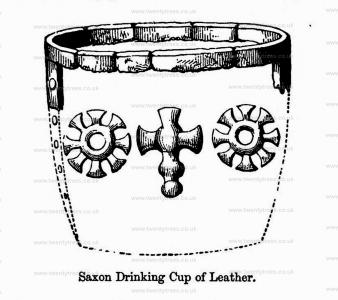

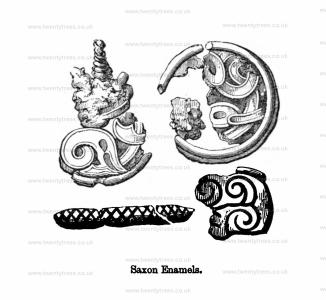
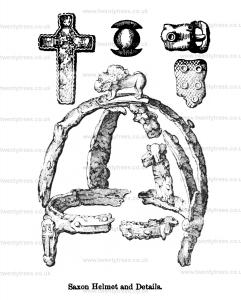
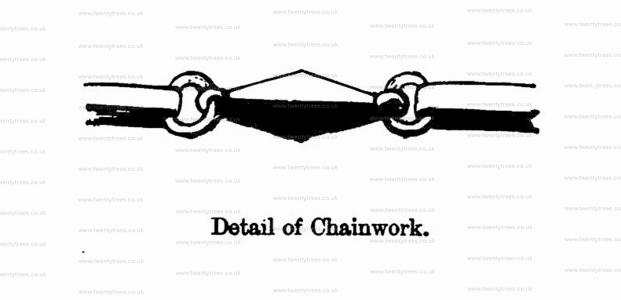




Books, Prehistory, Ten Years' Digging 1848, Barrow near Ecton
On the 6th of May was opened a small barrow at the summit of a rocky-hill, near Ecton mine, called by the natives "The Comp." One side of the mound was formed by a natural elevation of rock, the other consisted of large stones piled up against it in such a manner as to leave a hollow place in the centre, which served as a cist for the original interments which had never been disturbed. These comprised the calcined remains of an adult, accompanied by a perforated bone pin and spearhead of flint, which had both passed the fire; and secondly, the unburnt skeleton of a very young child, which lay at the bottom of a cavity immediately beneath the ashes of its parent, as we may reasonably suppose them to be.
Books, Prehistory, Ten Years' Digging 1848, Shuttlestone near Parwich
On the 3rd of June we examined a mutilated barrow in a plantation upon Parwich Moor, called Shuttlestone [Map], which had originally been about four feet in height; it consisted of a compact mass of tempered earth down to the natural surface of the land, below which point, in the centre of the barrow there appeared a large collection of immense limestones, the two uppermost being placed on edge and all below being laid flat, though without any other order or design than was sufficient to prevent the lowest course resting upon the floor of the grave, inside which they were piled up, and which was cut out to the depth of at least eight feet below the natural surface; thus rendering the total depth from the top of the mound to the floor of the grave not less than twelve feet. Underneath the large stones lay the the skeleton of a man in the prime of life and of fine proportions, apparently the sole occupant of the mound, who had been interred whilst enveloped in a skin, of dark red colour, the hairy surface of which had left many traces both upon the surrounding earth and upon the verdigris or patina coating a bronze axe-shaped celt and dagger, deposited with the skeleton. On the former weapon there are also beautifully distinct impressions of fern leaves, handsful of which, in a compressed and half-decayed state, surrounded the bones from head to foot. From these leaves being discernible on one side of the celt only, "whilst the other side presents traces of leather alone, it is certain that the leaves were placed first as a couch for the reception of the corpse with its accompaniments, and after these had been deposited, were then further added in quantity sufficient to protect the body from the earth. The position of the weapons with respect to the body was well ascertained; and is further evidenced by the bronze having imparted a vivid tinge of green to the bones where in contact with them. Close to the head were one small black bead of jet and a circular flint; in contact with the left upper arm lay a bronze dagger with a very sharp edge, having two rivets for the attachment of the handle, which was of horn, the impression of the grain of that substance being quite distinct around the studs. About the middle of the left thigh bone was placed the bronze celt, which is of the plainest axe-shaped type. The cutting edge was turned towards the upper part of the person, and the instrument itself has been inserted vertically into a wooden handle by being driven in for about two inches at the narrow end - at least the grain of the wood runs in the same direction as the longest dimension of the celt, a fact not unworthy of the notice of any inclined to explain the precise manner of mounting these curious implements. The skull, which is decayed on the left side, from the body having lain with that side down, is of the platy-cephalic form, with prominent parietal tubers - the femur measures 18½ inches.
Books, Prehistory, Ten Years' Digging 1848, Booth Low near Longnor
June the 9th we opened the second of three large barrows at Booth Low, the first of which had been excavated not long before by a resident in the neighbourhood, who discovered a deposit of calcined human bones near the centre of the tumulus, unaccompanied by any urn or instrument. Each of the barrows is about forty yards ill circumference, and eight feet high: that under consideration is nearest the village of Longnor [Note. Booth Low Barrow 1 [Map]]. One successful section through the middle shewed that the funeral rites had been performed upon the spot, the body having been reduced to ashes on the natural level of the ground, the remains were then gathered into a heap and covered with a layer of clay, above which a large fire of oak timber was made, the remains of which, in the shape of large pieces of charcoal, perfectly exhibiting the characteristic grain of oak, were then covered up with successive layers of tempered earth, mixed with a few stones, by which means the mound was formed. A few chippings of flint and a small piece of stag's horn were noticed in the course of the excavation.
On the 23rd of June we made an unsuccessful examination of the third barrow at Booth Low, situated near the last [Note. Either Booth Low Barrow 2 [Map] or Booth Low Barrow 3 [Map]]. With the exception of a few pieces of charcoal, there were no indications of interment observed during the progress of a very large cutting through the centre, which was extended to a slight depression below the natural surface, making the entire depth from the top of the mound rather more than eight feet.
Books, Prehistory, Ten Years' Digging 1848, Low Bent
On the same day was opened a smaller barrow at Low Bent, situated on low ground about half-a-mile from the last. Near the centre was a deposit of calcined human bones, placed on the level of the natural soil, and surrounded by an irregular circle of sandstone boulders; accompanied by a piece of stag's horn worked into an oval shape, three good spear points, and two rather indefinite instruments of flint, all which had been submitted to intense heat, probably from having accompanied the remains of their owner on the funeral pile. The flints have acquired a glazed appearance from the fusion of their surfaces. At a short distance from this interment the ground appearing to have been cut out and refilled with stones, we removed them to the depth of 18 inches, when we found a second deposit of burnt human bones placed amongst the stones, without any article or weapon whatever. The ground still shewing proofs of its having been disturbed, the work was resumed, until about two feet more of stone and earth being thrown out, we had the satisfaction of arriving at the solid floor of the grave, on which lay another heap of calcined bones, with one solitary bead of jet amongst them, of very primitive form, being only a rough piece perforated. The entire depth, from the apex of the mound to the bottom of the grave, was about five feet, three feet being below the natural surface.
Books, Prehistory, Ten Years' Digging 1848, Round Low
On the 5th July, a barrow called Round Low [Map], near Harborough Rocks [Map], on Hopton Moor, was opened; but, owing to the labours of former excavators, we met with but little success, all the middle of the barrow having been removed. Yet sufficient traces of the original interment remained to determine its character. The deposit appears to have consisted of calcined bones, accompanied by a few inferior flints, enclosed within a coarse urn.
Books, Prehistory, Ten Years' Digging 1848, Crake Low
On the 6th of July the remainder of a mutilated barrow near Tissington, called Crake Low [Map], were explored, attention having been directed towards it by human bones being dug up by persons destroying the mound for the sake of the limestone to be found in it. Upon making a section across the presumed centre of the barrow, which had long sinqe been levelled with the ground, we met with two interments which had escaped the general ruin; but which, owing to their nearness to the surface, were in an advanced state of decay. They consisted of the skeleton of a young person, accompanied by two calcined flints; and a deposit of burnt human bones, with one burnt flint, both placed within a rough cist formed of limestones set on edge; between the two was a small vase of coarse clay, 5½ inches high, perfectly devoid of ornament.
A further discovery of two skeletons and a very small plain rase, which was placed at the head of one of them, was made by some labourers opening a stone quarry near the edge of the mound in December, 1850. The vase and part of the skulls are preserved at Lomberdale House [Map].
Books, Prehistory, Ten Years' Digging 1848, Dowel or Dower
July 10th we opened a small mound on the summit of a hill called Brownedge, near Church Stemdale; it was raised about two feet above the natural level, and covered a grave three feet deep cut in the sandstone rock. The grave was filled, and the barrow was entirely constructed with stones mostly of grit, but with the addition of a few pieces of limestone, which must have been carried a mile or two to the place. Having removed these materials to within six inches of the bottom of the grave, without meeting with anything more important than rats' bones, we were much annoyed by the appearance of a considerable quantity of water, which effectually prevented any view of the floor of the grave, or the objects there deposited, and rendered it necessary for us to fish for the expected treasure. The interment had been by inhumation, and, owing to the wet, very few traces of the skeleton remained, and these were in great decay. The body was accompanied by a small and elegantly ornamented drinking cup, 6¾ inches high, which from the circumstance above named was recovered in a very dilapidated condition; a conical stud of jet with the usual double perforation, and two flints, one of them an arrow point.
Books, Prehistory, Ten Years' Digging 1848, End Low
On the 13th of July we re-opened the large barrow at End Low [Map], which was first attempted in 1843, without our finding the primary interment. Our researches this time resulted in the discovery of the remains of the original occupant, which were, after the expenditure of much labour, found in a cist cut down in the rock to the depth of six feet beneath the natural surface, and upwards of ten feet from the top of the barrow. The skeleton was that of a finely proportioned man, rather above the middle size, and was in good preservation, with the exception of the head, which was decayed at the left side, from contact with the floor of the grave. The bones lay apparently without much regularity, which was attribute able to the settling down of the stones upon the body during the process of decay. At a small distance from them was a bronze dagger and spear head of flint, of a grey colour. The grave was bounded on three sides by rock, and the remaining one was walled up to a level with them with loose limestones. The skull is engraved in the Crania Britannica, and is described by the learned writer as "a well-formed head, presenting very clearly the conformation of the true ancient British cranium, of which it may be regarded as belonging to the typical scries." The femur measures 18.8 inches.
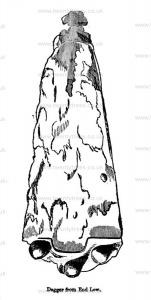
Books, Prehistory, Ten Years' Digging 1848, Moneystones
There are two barrows in the valley adjoining a hill near Hartington called Casking Low, which are commonly called Moneystones. The largest [Map] [Moneystones Barrow 1 [Map]] has been nearly removed, for the sake of the limestone it contained, and has been further rifled by treasure-seekers allured by the attractive name. On this account our researches on the 15th of July proved unavailing, as we found nothing but fragments of human skeletons and bits of flint. The smaller barrow [Map] [Moneystones Barrow 2 [Map]] is in the same field, about one hundred yards from the other, measures about six yards across, and is surrounded by a circle of large limestones, whose grey and lichen-covered surfaces, rising above the turf, present a venerable and old-world appearance. Near the surface, about the centre, we found a skeleton having no implements. Somewhat lower down the earth at first sight appeared to be quite undisturbed; but on closer examination we detected particles of charcoal, and consequently proceeded till, at the depth of about a yard, we discovered two more skeletons, lying in the usual contracted posture upon the top of the natural rock. They were both much decayed, and had each but one spear head of flint, though they were surrounded by a slight sprinkling of chippings of the same material.
Books, Prehistory, Ten Years' Digging 1848, Longstone Edge
On the 17th of July we broke ground in a fresh district, by opening a barrow near Longstone called Blake Low [Map], which had been a good deal mutilated by the removal of stone. Nevertheless we found the interment in the centre to be quite undisturbed, though the remains of about six individuals in a rude cist close by were in a state of the utmost disorder. These were accompanied by four neat instruments of flint, and the remains of a curiously-decorated urn. The preservation of the central deposit was owing to the body having been laid in a grave cut in the rock to the depth of two feet. The skeleton was that of a very young woman, or rather of a girl, and lay on the left side, with the knees drawn up. At the head was a drinking cup, rather more globular in form than usual, 7½ inches high, the upper part ornamented by parallel grooves; and along with the skeleton were the bones of an infant, with the tine of a stag's antler. The grave was filled up to the level of the natural soil with limestone, amongst which was as large an accumulation pf the bones of the water-vole as we have seen in any barrow.
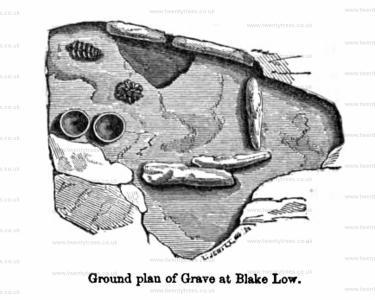
On the 25th of July we opened another barrow, at no great distance from the last, situated on a more elevated point of the "Edge." Its mutilated appearance gave rise to no very sanguine expectations of success, and we were, therefore, neither surprised nor disappointed by finding, on examination, that the mound had been thoroughly rifled. There were some very large limestones placed on edge for a considerable length in the centre of the barrow, but whether they had been portions of cists that had been removed by former excavators, or not, is uncertain. In all parts of our diggings we observed scattered pieces of bone pertaining to skeletons, both human and animal; amongst the latter were those of the horse, ox, hog, dog, water rat, and a few specimens of the beaks of birds. The only manufactured remains were two small pieces of a drinking cup, and a circular flint which has been calcined.
On the 29th of August we opened another barrow, near the last, situated on a part of the hill still more elevated. Externally it has the appearance of a cairn or tumulus solely composed of stone, which in fact it was, so far as artificial means had been employed, but in the middle the rock rose above the natural level, and caused the tumulus to appear of greater extent than it really was. In the centre was an irregularly shaped rock grave, about three feet deep, lined with flat stones placed edge-way, and covered with four or five large slabs laid over it without much regularity. It contained a deposit of calcined bones, evidently of an adult, with bits of stags' horn intermixed, laid in a heap near the middle of the grave, which was the chief interment; in one comer was the decayed skeleton of a child of tender age, around which were numerous rats' bones; and in the opposite corner were two vases of different shapes, something like those found at Arborlow, (Vestiges, p. 65,) which yet stood upright in their original position, and contained nothing but fine mould; casually were found some cows' teeth, two hoofs of deer, and a bit of flint. Having cleared out the grave, a triangular hole, measuring about a foot each way, was found to have been sunk at one side to the depth of 18 inches. As we found nothing in it but a few fragments of bone, it is possible that it was originally made to receive the vases, and was abandoned because too small to hold them conveniently; or it might have had some connection with a prior interment, as we found a portion of the cranium of another subject just outside the lining stones of the grave.
The analogy between the Arborlow deposit and the present is very remarkable the interment in each being by cremation each accompanied by two vessels, and the vessels in each case being of relatively distinct forms, that is to say, a highly ornamented one, with an opening wide in proportion to the height, and a plainer one in which this peculiarity is not seen.
Books, Prehistory, Ten Years' Digging 1848, Middleton-by-Youlgreave
On the 10th of November we commenced excavating a barrow in a plantation near Kenslow Wood, called Rusden Low [Map], where a skeleton was found by the planters in May 1828. Being situated on a natural rising of the land it had been quite overlooked till the previous day, when it was noticed whilst shooting. The first step was to cut as near the centre as possible, and the result was the discovery of a skeleton, lying on its left side, with the knees drawn up, in a slight depression in the rock which was very near the surface. The lower extremities were quite undisturbed, although the upper part of the body had been much injured at a former period, perhaps by the planters. In the course of the day we found the relics described below, none of which occupied any well-defined position in connection with the skeleton, though they were not far from it. It will be seen that they are of various ages, commencing with a neat spear point of flint burnt white, and a tine of stag's horn, found near the feet of the body; and a flint arrow near where the head should have been. Outside the depression in which the body lay was part of a very neatly made comb, composed of several pieces of bone rivetted between two strong ribs of the same with iron pins: it had been furnished with teeth on both sides, which were nearly all broken away. The blade of a clasp knife of iron, apparently very ancient, as it is completely oxydized through the substance of the metal; and a small brass coin of Constantius Chlorus, reverse Victoriae Laetae Princ Perp.; teeth of animals, and pieces of Romano-British pottery were found throughout the cutting, which, with the comb, knife, and coin have probably been deposited with a much later interment than that which we found.
November 11th we continued the examination without success until near dark when we found a long grave in the rock parallel with the depression occupied by the former skeleton, and not more than a yard from it. It was eighteen inches deep, and covered with large stones; in it lay the skeleton of a young female, as usual on the left side, in a contracted posture. Before the face were indications of the skeleton of a very young child, and a highly-ornamented drinking cup of red clay, which lay crushed upon its side with the mouth towards the feet of the skeleton: it contained one broken instrument of flint. It was evident that the grave had been occupied by a previous tenant, whose bones, together with the remains of another drinking cup beautifully decorated, and a bit of stages horn, had been collected and placed under one of the large stones that covered the grave. This had clearly been done at the time when the female was buried. Owing to the lateness of the hour at which this interment was found, we were obliged to clear out the grave by candlelight, and thinking that something further might be discovered by day, we resumed the search on the 13th of November, but found only one rude flint arrow point in the grave; and a piece of a sandstone quern in refilling the excavation. There were many rats' bones in some parts of the mound, but not in the profusion sometimes met with.
Books, Prehistory, Ten Years' Digging 1848, Youlgrave
On the 16th of November we opened a small barrow [Map] [Meadow Place Barrow [Map]] in a field on Meadow-place Farm, called Greenstor Meadow, close to the Conksbury road-side. The land having long been under tillage may account for the flatness of the barrow, and for the little success that attended our researches, which were rewarded by a few scattered articles only, there being no perfect interment found, although we detected remains of two human bodies, one of them calcined. There were also bones of rats, the tibia of a cow, a few instruments of flint, and a good specimen of a spear of the most primitive description, made from a large splinter of dense animal bone, nicely ground or rubbed to a point. It measures seven inches in length, and illustrates the account of Tacitus wherein he describes the more barbarous German hordes as using bone points to their weapons, owing to their ignorance of metal.